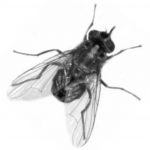Bulletin #5002, Integrated Pest Management for Fly Control in Maine Dairy Barns
Bulletin #5002, Integrated Pest Management for Fly Control in Maine Dairy Barns (PDF)
Prepared by Patricia Westenbroek, Extension integrated farm educator
For information about UMaine Extension programs and resources, visit extension.umaine.edu.
Find more of our publications and books at extension.umaine.edu/publications/.

Noticed a few flies around? A silly question, perhaps, about a serious issue. Flies around the barn and milking parlor are a nuisance to the cows and to us. How can we manage the level of flies in our dairy operations? A multi-pronged approach, called Integrated Pest Management (IPM), is the key.
Economic problems caused by high housefly populations in dairy operations:
- Reduced milk production: cows must expend extra energy fending off flies.
- Reduced farm worker productivity: flies interfere with work such as feeding and milking.
- Increased frequency of animal disease transmission, leading to
- increased medication costs, and
- increased veterinary service costs.
- Increased risk of complaints and legal action from the public.
- Increased potential for spread of human diseases.*
The first step in every IPM program is to learn about the pests that are causing the problem. On dairy farms, the primary fly perpetrators are the housefly and the stable fly.
The housefly (Musca domestica) is the most common and costly fly pest. The life cycle of the housefly can be completed in 10 days during warm weather. In a few more days, an adult fly will emerge to mate and start the next generation. Since each female housefly lays 150–200 eggs, and one pound of manure can contain more than 1,500 maggots, it is important to take steps to break the life cycle.
- House Fly. Image courtesy of Cornell University.
- Stable Fly. Image courtesy of Cornell University.
Stable flies (Stomoxys calcitrans) are similar in appearance and lifestyle to houseflies, with one important distinction—they bite! Like the housefly, the stable fly enjoys a moist, decaying environment. Since this is a blood-feeding fly, its economic impact can be large. Stable fly populations can lower milk production by 15 to 30 percent!
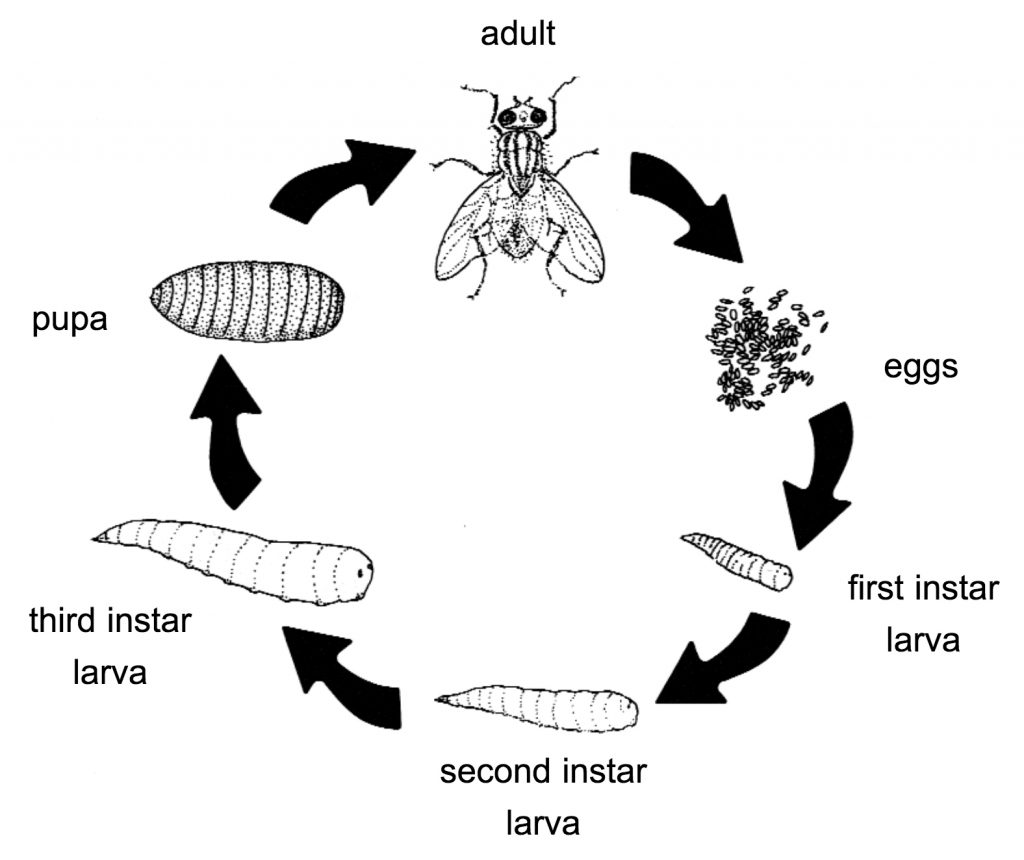
How Do You Control Flies?
Develop a plan:
- Determine current levels of fly populations: for instance, you could put up fly strips and record the frequency with which they need replacing. You need to know your starting point in order to track your progress.
- Identify an achievable goal: decide the level of flies you can live with (for instance, a low enough population level that strips only need replacing once a week).
- Map out a way to get there: develop an IPM plan for keeping fly populations below unacceptable levels. Your plan should include elements of each of the four control categories described below.
- Act early! Fly populations start building when the weather warms up, so begin your fly control program in early spring.
- Track and evaluate your progress. Use sticky tapes or speck cards to monitor fly activity in and around barns and the milking parlor. Keep records of how fast they fill up. Record any control actions you take, and when they were taken. Evaluate what worked and why.
Cultural Control
The biggest part of cultural fly control is sanitation. Good sanitation is the most practical and economical way to manage fly populations. It’s best to begin before the flies have had a chance to develop into large populations.
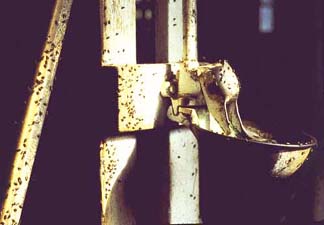
Think clean and dry:
- Keep open feeding lanes and the concrete corners of the feeding bins clean.
- Clean out calf hutches and holding pens on a regular basis and keep them ventilated. Move portable hutches on a regular basis and elevate one of the sides to provide extra ventilation if necessary. Calf areas are prime spots for fly breeding.
- Completely clean the entrance and exit lanes of the milking parlor daily, or after each milking.
- In liquid manure pits, prevent floating mats by collecting debris from the runoff collection channels, sediment basins and retention ponds.
- Get out your weed whacker and mower! Keep the entrance and exit walkway corners weed-free and trimmed to allow weekly cleanup of collected manure. Keep vegetation around barns, feeders, hutches, and manure piles mowed to eliminate fly resting areas.
- Remove small piles of manure and spread out straw as frequently as possible.
- Dispose of mortalities and afterbirth immediately.
- Keep animal areas as dry as possible. Scrape out manure regularly, and provide a three to four percent slope to allow drainage of liquid from stalls.
- Clean hard to reach areas such as behind waterers, in corners and under pen partitions.
- Clean the manure spreader when not in use: it’s an ideal place for flies to breed and be transported.
- Keep areas around feed storage, feed bunks and watering tanks free from moisture and manure. Fix water leaks promptly.
- Move your round bale feeder regularly to prevent manure, urine, and hay buildup.
- Keep flies out of milk rooms by maintaining window screens (use 14–16 mesh) and keeping doors closed whenever possible.
Remember: clean and dry.
Biological Control
Nature can help in the battle against flies by providing natural enemies. These include predatory beetles and mites, parasitic wasps, and fly pathogens. You can promote natural enemies by keeping facilities clean and dry, and limiting pesticide use.
Predators: Hister beetles occur primarily in older manure packs. These small, black, shiny beetles consume up to fly 24 eggs a day. Predatory mites also feed on housefly eggs as well as small maggots.
Parasites: Parasitic wasps look like tiny gnats. Although they are harmless to humans and cattle and go unnoticed in dairy operations, they effectively find and kill fly pupae. The life cycle of most wasps is about 3 weeks long. There are wasps commercially available for release to augment the natural populations that exist.
When using biological control, remember that it is only one piece of a complete fly management program and, like many other components, will not eradicate flies entirely when used alone. Integrated pest management is a multi-method approach.
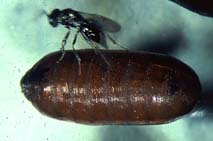
Tips for Using Parasites
If using parasites, find a reputable supplier, and ask specifically for Northeast-adapted strains. Research and experience have shown that the wasp species Muscidfurax raptor is most effective in northeastern dairy operations.
Follow the directions provided by the supplier. Ask questions of your supplier to ensure that you are getting a high quality and suitable product shipped and delivered in a timely and dependable manner.
Don’t forget that these are living organisms—make sure the package isn’t left in the heat or cold—and release the wasps as soon as possible. It is best to begin releases in the early spring to establish the species and get a head start on the fly population. Parasites perform best in enclosed environments like calf hutches; their benefit is less noticeable in open environments.
Chemical Control
There are a wide variety of chemicals to control flies. Before using any chemical, always check with the Maine Board of Pesticide Control** to see if it is registered for use in this state and what regulations pertain to its use. Always follow the label’s instructions.
There are chemical controls for organic producers too. These chemicals such as pyrethrins and citric acid are naturally derived from plant materials. Contact Maine Organic Farmers and Gardeners Association (MOFGA)*** for information. Before using any spray on an organic farm, contact both MOFGA and the Board of Pesticide Control.
Physical Control
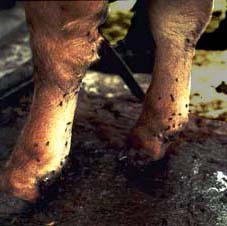
Tapes, traps, and lights are forms of physical control aimed at attracting and killing the adult fly. These can be very useful as part of an integrated pest management system. Use traps in areas where the use of chemicals is difficult, ineffective or unacceptable, such as milking parlors, milk holding rooms, and feed holding and mixing areas. Be sure to keep physical controls maintained for maximum effect.
IPM Strategy
Integrated pest management is a management strategy incorporating a number of control methods that complement one another and work together. By using cultural control, biological control, chemical control and physical control as pieces of a complete plan, you can economically and effectively manage fly populations.
Here are seven principles to aid you in decision-making:
- Plan a strategy. Set an attainable goal; make a plan that employs more than one method to control flies; implement it; measure your progress; and keep it simple and flexible. Also, have a contingency plan if setbacks occur.
- An ounce of prevention is worth a pound of cure. Start before the flies do! Begin your plan of action before fly populations begin to build. When warm weather arrives, monitor fly activity, adjust to new situations like changes in weather, don’t repeat what doesn’t work, and keep up your efforts through the whole season.
- Use what you need to get the job done. If using pesticides, follow the label instructions and avoid unnecessary applications. Be decisive and take the necessary actions.
- Use fly weaknesses to your advantage. Flies are hard to control because they have a short generation time, are prolific, and can detoxify many poisons. But habitat changes make them more susceptible to natural control factors. By keeping the barn clean and dry, you can increase the generation time and lower their reproductivity. Careful use of insecticides will help minimize resistance to pesticides and protect natural enemies. By using a variety of control strategies in an integrated program, you can attack fly weaknesses on multiple levels.
- Make sure the pieces of your plan work together.
- Monitor fly populations through the whole season. Be flexible: respond to changes in fly populations with corresponding changes to your IPM program. Take the time to understand situations as they develop.
- Don’t get in a rut. Use new practices if the flies become adapted to what you are using.
For more information about fly control, contact your local UMaine Extension Office.
Special thanks to Kathy Murray, IPM entomologist, Maine Department of Agriculture, Food and Rural Resources, for her role as peer reviewer of this fact sheet.
This fact sheet was adapted with permission from the following publications:
Donald A. Rutz, Christopher J. Geden and Charles W. Pitts. Pest Management Recommendations for Dairy Cattle. New York: Cornell and Penn State Cooperative Extension. Retrieved from the World Wide Web March 22, 2002 at http://www.entomology.cornell.edu/Extension/Vet/PDF_Files/Cattle_Recom2000.pdf
D. Wes Watson, J. Keith Waldron and Donald A. Rutz. Integrated Management of Flies in and around Dairy and Livestock Barns. New York State Integrated Pest Management Program, Cornell Cooperative Extension. Retrieved from the World Wide Web March 22, 2002 at http://www.nysipm.cornell.edu/factsheets/dairy/barnflies/barnflies/html.
Douglas E. Stevenson, Extension Associate – Agricultural Chemicals, and Dr. Jesse E. Cocke, Extension Entomologist. Integrated Pest Management of Flies in Texas Dairies Pub E-26. Texas Agricultural Extension Service.
*Source: Douglass E. Stevenson and Jesse Cocke, Integrated Pest Management of Flies in Texas Dairies, Texas Agricultural Extension Service, 4.
** Maine Board of Pesticide Control: Augusta 207-287-2731; Presque Isle 207- 764-2039 TDD: 207-287-4470
*** Maine Organic Farmers and Gardeners Association: 207-548-4142
Information in this publication is provided purely for educational purposes. No responsibility is assumed for any problems associated with the use of products or services mentioned. No endorsement of products or companies is intended, nor is criticism of unnamed products or companies implied.
© 2002
Call 800.287.0274 (in Maine), or 207.581.3188, for information on publications and program offerings from University of Maine Cooperative Extension, or visit extension.umaine.edu.
The University of Maine is an EEO/AA employer, and does not discriminate on the grounds of race, color, religion, sex, sexual orientation, transgender status, gender expression, national origin, citizenship status, age, disability, genetic information or veteran’s status in employment, education, and all other programs and activities. The following person has been designated to handle inquiries regarding non-discrimination policies: Sarah E. Harebo, Director of Equal Opportunity, 101 North Stevens Hall, University of Maine, Orono, ME 04469-5754, 207.581.1226, TTY 711 (Maine Relay System).


